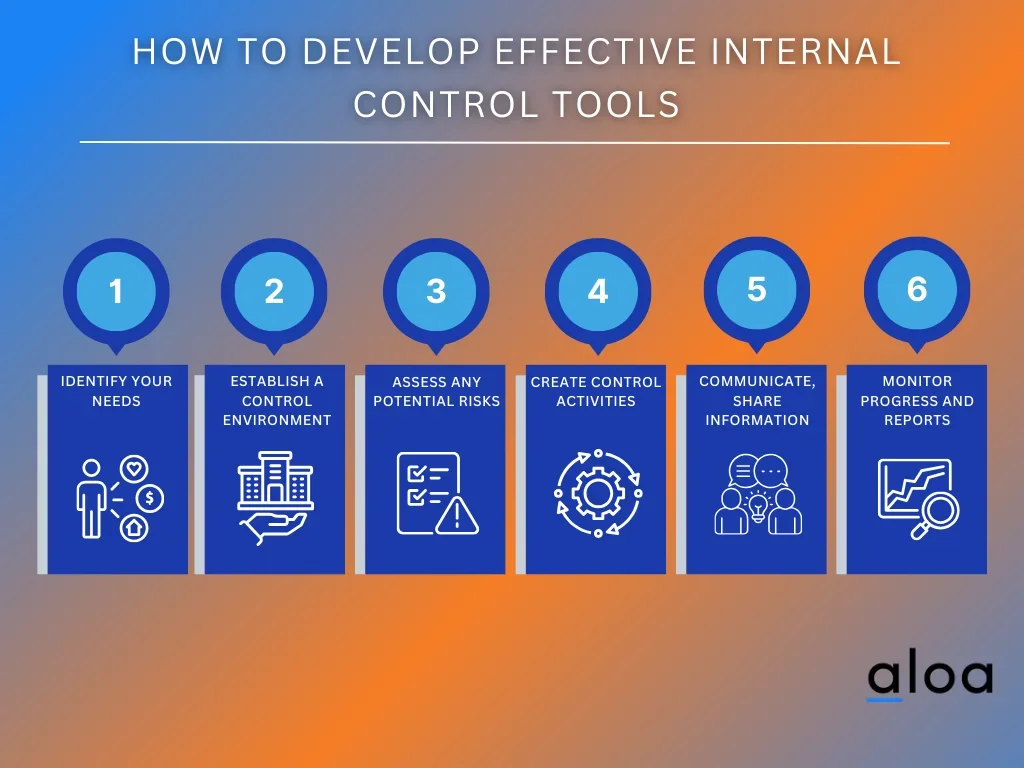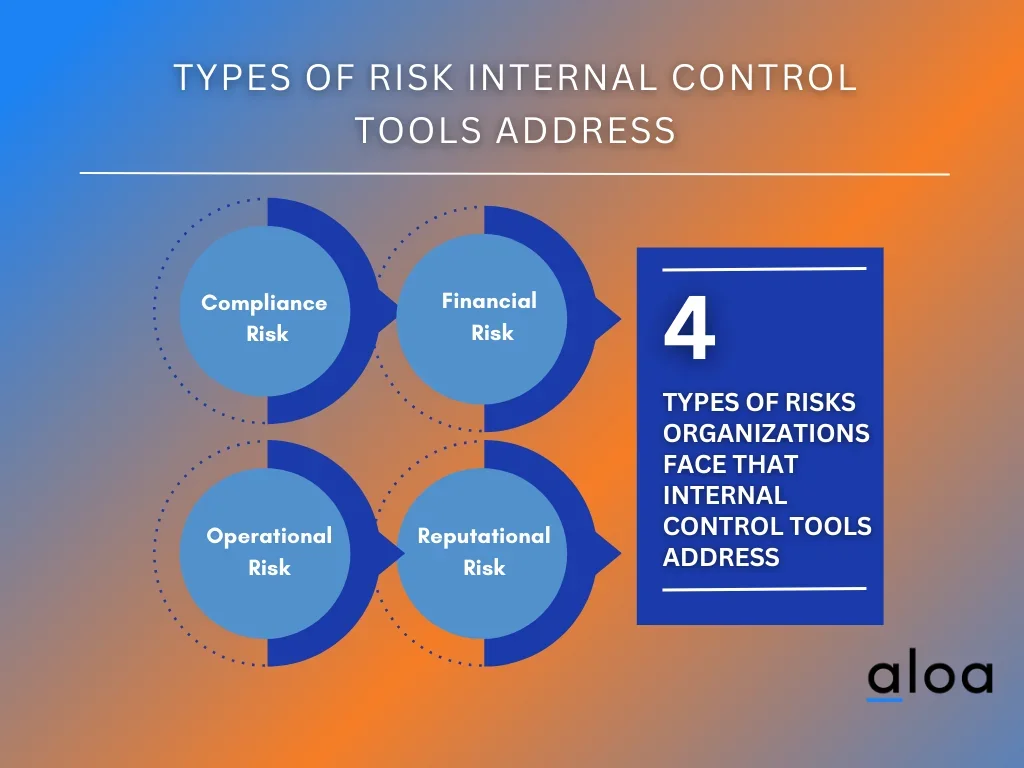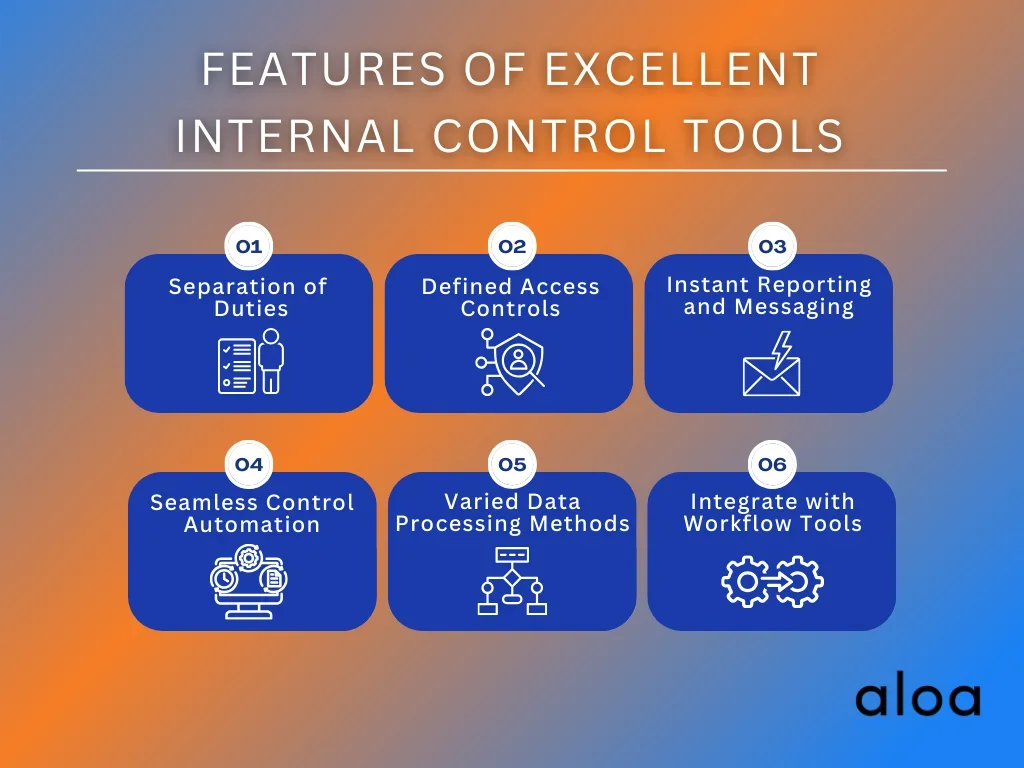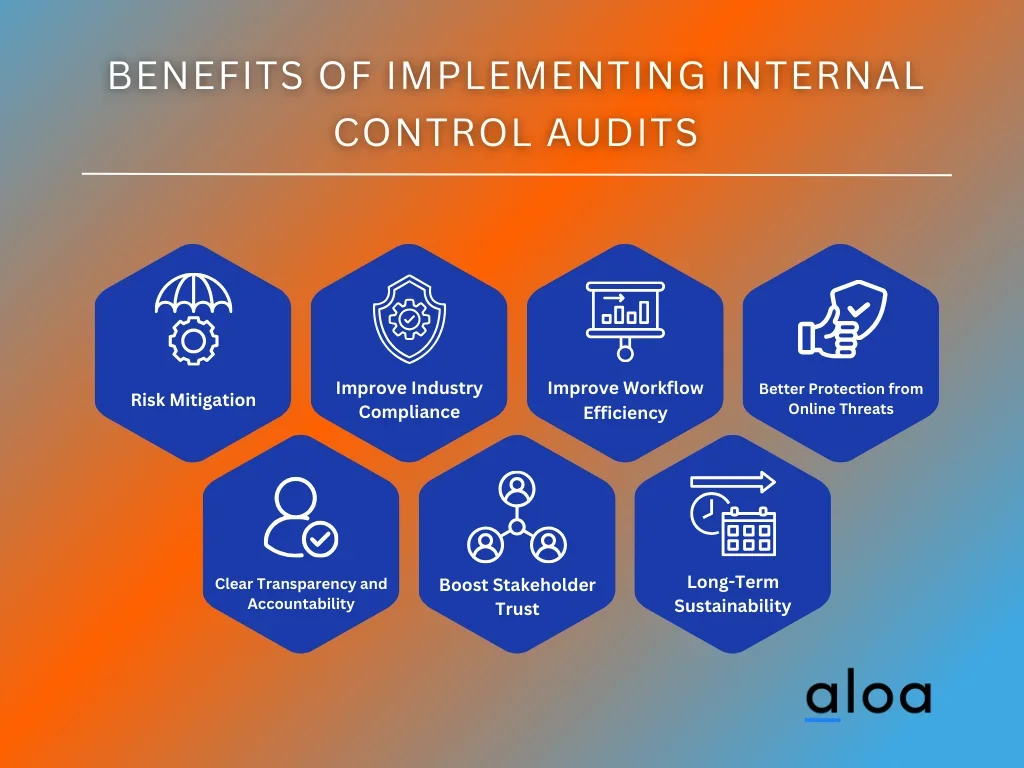Internal control tools provide startups and businesses with added security mechanisms that safeguard their physical and digital assets. Today, it's common for companies to face risks such as hacking and malware that could potentially lead to financial loss and data breaches.
On the other hand, internal control tools provide an extra layer of protection that can help mitigate such risks. Developing internal control tools goes a long way in ensuring your business remains protected while keeping your reports consistent across the board.
As a startup, Aloa understands the importance of an effective internal control tool. With the proper control tools, managing a business becomes more manageable. Additionally, knowing that there is always a chance of financial issues occurring due to data breaches, malware attacks, and other security threats. We have learned from our experience that there are a few steps to consider and bear in mind when developing internal control tools.
In this article, we'll share our insights into how to develop practical internal control tools, the types you can consider, and the features that you should look out for as you finalize your decision. By the end, you'll know how to develop and implement internal control tools for safeguarding organizational data by implementing internal control audits, risk assessments, and other end-to-end security procedures.
Let's get started!
What Are Internal Control Tools?
Internal control tools refer to a system in place that monitors, tracks, and corrects all records made by a company. These tools ensure that all reports comply with the regulatory laws, policies, and practices while ensuring integrity in audits.
Businesses can use internal controls to manage various components within the company. Internal control tools also aid in preventing possible anomalies or errors in reports and keep the updated information stable and consistent.
How To Develop Effective Internal Control Tools
Learning how to develop internal control tools enables businesses to safeguard their assets and create efficient procedures to manage and deal with risks. The main point of developing practical internal control tools is identifying any possible risks that could affect your business and managing the issue immediately.
Any vulnerable components in a company can cause long-term issues that could affect productivity and hinder any potential progress. To prevent such risks from arising, here is a step-by-step process outlining how to start developing and applying internal controls:

Step 1: Identify Your Needs
The first step in developing and establishing reasonable assurance internal control tools to use for your business or startup is to identify why you need them in the first place. There are a handful of use cases and types of internal control tools, and narrowing down what aspect of your business requires it most makes it easier to decide how to proceed.
Determining your needs and requirements helps you decide which system works best for you while also forecasting any future changes that may come into play. Doing so allows businesses to create control tools capable of accommodating various operations and procedures needed for their operations.
Here are the main types of internal control tools to consider:

Detective Control
Detective controls quickly detect problems and can automate corrective action to prevent further loss. Spotting any glaring discrepancies or anomalies is the main ingredient in making internal control tools effective.
With a detective control mechanism in place, you can establish automatic lockdown procedures or restrict access to the company's sensitive data while providing a highly detailed audit. This is all part of the detective controls most businesses focus on with their control tools.
Preventative Control
With preventative control, the main goal is to prevent any issues from arising through monitoring and assessment to ensure you can detect any risks before they occur. Having the opportunity to catch any potential risks greatly benefits businesses by minimizing the resources needed to fix any issues and avoid potentially damaging situations.
Factors such as preventing cyber-attacks, fraud, malpractice, and general accounting errors can be easily spotted using features such as financial authorizations, automatic data backup, segregation of sectors, and advanced firewall and intrusion prevention systems.
Corrective Control
Corrective control aims to resolve issues that arise from situations such as a data breach or accounting error. Corrective control can determine how much a company can recoup or fix its losses while ensuring that no other problems can arise.
Constantly updating software patches and company policies to deter loopholes in the business's security and integrity. Verification of ledger authorization and the ability to quarantine sensitive information are all aspects of corrective control that are vital for all businesses.
Step 2: Establish a Control Environment
A control environment is the foundation of every internal control system. It should be established before any other steps are taken. To create an effective environment, you must ensure all stakeholders understand the value of setting up the proper controls for success. It's essential to maintain clear communication with everyone so that they are aware of the goals for setting up these controls.
Control tools operate best when they adhere to the standards set by the company's policies and practices. Establishing a proper control environment based on your employee's capabilities and skills will make programming internal control tools faster and easier.
Top-level executives and managers should consider a controlled environment as the foundation for all their organizations and employees to guarantee consistent and reliable financial reporting and responsibility.
Step 3: Assess Any Potential Risks
Your controlled environment will help you pinpoint and address any weaknesses that can be utilized for malicious intent. Since internal control tools aim to prevent, address, and control any risk posed to a business, take note of the potential risks that arise in this controlled environment.
Afterward, you effectively create your internal control tools to specifically manage high-risk situations that are most likely to occur. Here are a few types of risks to evaluate:

- Compliance Risk: Focuses on making sure your organization complies with government, legal, and business practice terms, preventing any liability to your business.
- Financial Risk: Ensures you are aware of your oganization's cashflow towards ensuring a healthy credit line and preventing your business from being labeled as a financial risk.
- Operational Risk: Prevents your business from running into situations wherein it needs to halt its operations. In such cases, operational risk tools help you stay operational with the appropriate coverage such as those caused by environmental factors.
- Reputational Risk: Establishes processes that mitigate the damage done to a company's repuation, whether it be how to reply to negative reviews or working past any sort of data breach or internal issues.
These risks contribute to your organization's effective and efficient risk assessment analysis. For instance, if you are worried about financial security, look into any processes dealing with money and examine how they can be modified to fit better control schemes while also identifying what potential issues could arise if certain regulations are ignored.
Conducting a thorough risk assessment is essential to ensure you can properly mitigate any risks using your internal control tools before they become a serious problem.
Step 4: Formulate Comprehensive Control Activities
Control activities refer to how internal control tools will react based on the given error at hand. Since identifying and evaluating risks are only one part of internal control tools, it is vital that you also develop the appropriate control action to help contain or correct the problem before it affects the integrity of the organization.
Control activities are essential to managing these risks regardless of whether they are preventative, detective, and/or corrective actions. Each component should coincide with the company's policies and regulations for seamless action and reaction.
Carefully consider each control activity and ensure that the process is as detail-oriented as can be to ensure any delays when a financial dispute or error is detected. Once the problem has been ascertained, ensure that an appropriate corrective action is applied for the best results.
Step 5: Ensure Constant Communication and Information Sharing
Monitoring and controlling discrepancies are only effective if the people involved can have constant updates with constant communication through report sharing. Consistently sharing reports and communicating will allow each organization member to follow through with their obligations and responsibilities.
Utilizing different workflow programs alongside the data reports received from the internal control tools can alleviate some of the time-sensitive pressure of containing or correcting a recently discovered anomaly.
Auditors and individuals in higher management positions should have consistent access to one another to ensure that corrective measures are met promptly. The information can also significantly impact the company's integrity to potential clients if the anomaly is not resolved immediately.
Step 6: Monitor Progress and Reports
Internal control tools allow managers and auditors easy access to the financial reports while securing the information from being leaked to various sources. The reports also ensure that any "spots" or irregularities in the financing department can be easily fixed over time.
Regularly scheduled monitoring can make it easy for both auditors and personnel to easily determine any risks to prevent the problem from snowballing into a bigger problem than it is. Any issues the auditors see should be immediately addressed to management for immediate action.
Features of Excellent Internal Control Tools
Each control tool can vary depending on how it's developed and the needs of the organization. Developing the perfect system that matches the company's policies and regulations allows for a more dynamic shift into positive workflow.
Here are some excellent features to look out for when developing internal control tools:

Segregation of Functions and Duties
Segregation of functions allows management to directly control which components an individual can use to complete a project or assessment. Effective and detailed segregation of duties can also minimize the risk of errors, especially in smaller teams or groups.
Critical tasks require careful attention to detail. Managing business financials can be easier by implementing a segregation of function feature in your organization's internal control tools. This feature allows companies to divide tasks and responsibilities among employees to establish consistent checks and balances.
Defined Access Controls
Restricting access controls for specific individuals lowers the chance of false information or misunderstandings arising when drafting reports. An effective internal control toolkit design should have flexible control when granting or revoking access to specific individuals within the organization.
On-Demand Reporting and Communication
Requesting immediate access to all financial reports through a detailed data analysis allows businesses to determine any anomalies in the company's assets and finances. Effective internal control tools will have a system in place that will provide routine reports and systematically compare based on any possible changes.
Seamless Control Automation
Once the internal control tools discover an error in the expected financial data report, immediate actions must be taken to prevent the issue from escalating. Seamless reactive control automation allows the control tool to respond immediately.
System functions such as locking access to company data and finances, automated notifications to top-level management, and consistent data self-assessment are all integral in developing effective internal control tools.
Multiple Methods for Processing Data
Although receiving routine financial data reports can benefit management and auditors by inspecting for flaws, ensuring that the information is readable and presentable can help convince potential stakeholders or clients to understand the key aspects of the company's financial capabilities.
Having critical data and information processed in more than one server or type can also prevent the company from accidentally losing its sensitive data due to a data leak or cyberattack. Physical data processing, such as an automated hard drive backup, may also be beneficial for companies with many trade industry secrets.
Integration With Various Workflow Tools
Every successful business utilizes multiple programs or tools to improve the general workflow pace. Integrating your internal control tools with different software, such as communication or cloud-saving software, can make the learning and transition process much smoother for your employees.
Requesting your teams to utilize specific workflow tools can also ensure that top-level executives and management can easily control admin rights when controlling the spread of sensitive data is necessary when integrating audits with internal control tools.
Benefits of Implementing Internal Control Audits
Implementing internal control tools or audits allows companies to focus on other aspects of their business, such as growth scaling. Consider these tools as essential for maintaining financial stability, safeguarding company assets, and ensuring proper compliance with the regulations set.

Risk Mitigation
The ability to monitor all audits can help bring a sense of peace to every management as it can drastically reduce the risks of errors. Since internal control tools help identify, assess, and mitigate risks within the organization, you can spend more time placing your other assets in growing the business instead of correlating a large budget for security.
Better Compliance With Industry Regulations and Policies
Most industries will require businesses to follow a strict set of compliance policies that can affect a company's operational efficiency. Internal control tools can help enterprises avoid penalties and other legal issues that could hamper long-term stability. Remember that company policies and industry regulations should co-exist before adding them to your control toolkit.
Improve Workflow Efficiency
By allowing internal control tools to segregate various duties and obligations into different sectors, the organization will better understand which components of their organization require more attention than others.
Better Protection from Online Threats
Preventative and detective controls play a significant part in detecting and protecting a company from any fraudulent activities within the organization. The earlier a potential threat can be detected by the internal control tools, the faster corrective actions can be achieved.
Clear Transparency and Accountability
Constant monitoring and reporting through the internal control tools allows auditors to spot which factor causes the most problems in the company. A detailed data analysis on the documenting procedures and information can help increase accountability in the workplace.
Increased Company Trust With Stakeholders
Customers, partners, and potential clients can determine from a business' internal control reports the amount of reliability and integrity that the company has. A clearer footprint on the management of spending can decide whether a prospective project or client will be involved in the organization.
Long-Term Sustainability
Well-developed internal control tools will showcase how a company can progress in growth depending on its ability to spot potential risks. The sooner an organization can implement the proper control tools, the better likelihood they have of focusing their attention on expanding the reach of their specific industry.
Key Takeaway
Implementing internal control tools allows an organization to track, manage, and conduct extensive research based on the financial data individuals receive within the company.
Effectively developing an internal control tool that matches the company's needs and policies can also aid in preventing or correcting any risks and keep your potential clients and stakeholders informed.
Ready to start developing your effective internal control tools? Reach out to our Account Executives at [email protected] , where you'll get the chance to consult with our team of experts and explore the best solutions when it comes to developing your internal control tools, applying our development process.

